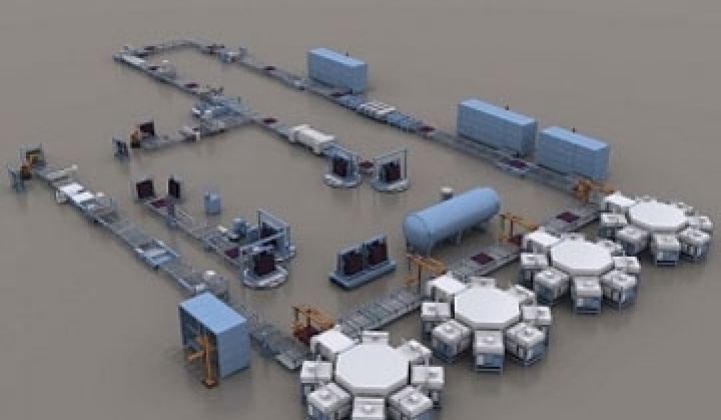In the past few weeks we've heard speculation and rumors that Applied Materials may try to to scale back or even sell its group that makes equipment for amorphous silicon solar panels. Tom Lacey, the general manager of the SunFab amorphous equipment line, and other SunFab execs have also recently resigned from the company.
Applied declined to comment on the rumors, confirmed Lacey's resignation, but emphasized that the company will invest more into the amorphous market.
"We are fully committed," said John Antone, corporate vice president of marketing in the energy and environmental solutions group at Applied. "We believe that Applied's a-Si is world class."
There you have it: Applied says it's in. But the debate raises an interesting question.
Why not get out?
While Applied is currently experiencing a growth spurt for its equipment for crystalline silicon solar panels, the company's amorphous business suffers from economic and technical woes that may not be easy to fix. (The crystalline amorphous debate will be one of the topics at the Solar Summit 2010 taking place later this month and sponsored by Greentech Media.)
Last year, prices for crystalline silicon solar panels plummeted and thin film king First Solar continued to drop its costs. As a result, amorphous silicon became more expensive relative to other solar panels.
"Few a-Si manufacturers are currently in a position to compete with the incumbent heavyweights," wrote GTM Research analyst Shyam Mehta earlier this year. While amorphous will likely become more competitive in two to three years, it's in a dip now, he noted.
But even within the amorphous world, Applied's SunFab equipment -- essentially a factory in a box -- is somewhat costly, said sources in the solar industry. Mehta estimated that SunFab equipment can cost up to 30 percent more than standard equipment.
Meanwhile, Applied has begun to lag competitors like Oerlikon in advancing its technology. Oerlikon has been more aggressive in promoting higher efficiency amorphous technologies like micromorph and tandem-junction technology. Making these panels involves adding an additional layer of silicon that boosts efficiency to 9 percent, and more advances are expected.
In the higher efficiency amorphous market, five of the top ten vendors are Oerlikon customers, said Mehta. Only one is an Applied customer. But in garden variety single-junction amorphous silicon, Applied lags, too. Oerlikon has four of the top ten vendors. Applied has two, and they rank seventh and ninth. Antone said that Applied expects its efficiency for tandem junction to rise to 9 or 10 percent and for single junction to rise to 7 to 8 percent, which could boost market share.
Amorphous has also gained something of an amorphous persona in the company. In February 2009, CEO Mike Splinter said that Applied did not expect new orders for solar equipment for a few quarters, maybe even until 2010. The company also imposed work shut-downs and furloughs.
Last April, an Applied customer cut an order for thin film equipment from $1.9 billion to $250 million.
This past November, Applied said it would cut about 10 to 12 percent of its workforce, or 1,300 to 1,500 positions, over the next 18 months. For the fiscal year 2009, which ended in October 2009, the Energy and Environmental Services group reported a $242 million operating loss. It was the only one of Applied's four groups to lose money. The year before, it lost $183 million and again was the only one in the red.
By contrast, Applied seems determined to increase its crystalline solar business. The company opened a solar technology center in China last year and moved company CTO Mark Pinto to China. In November 2009, it bought Advent Solar, which specializes in crystalline silicon equipment.
Interestingly, Applied raised its forecast for the current fiscal year in its financial release on February 17.
"We are raising our full-year revenue target to reflect higher anticipated demand in our semiconductor, LCD display and crystalline silicon solar businesses," Splinter said in a prepared statement.
Note the lack of comments on amorphous silicon in there.
Meanwhile, Applied Ventures and other groups within the company have begun to concentrate more on energy storage and solid state lighting.
A retreat from amorphous would obviously be embarrassing for the company. Applied got into solar in 2006 through amorphous silicon. It has also helped companies like Masdar PV and Signet Solar get into solar by providing them SunFab equipment and know-how. Some on Wall Street would no doubt demand that Splinter endure a public shaming.
But realistically, the furor would die down soon enough. Applied would likely find buyers. It could also retain parts and improve them. This wouldn't be the first time someone in semiconductor equipment backed away from a multimillion dollar bet. Anyone remember Intel's foray into Extreme Ultraviolet Lithography?
We asked a major solar executive at a company that makes both crystalline and amorphous solar panels if he had heard if Applied had any plans afoot to get out of amorphous. No, he said.
"But they should," he quickly added.



